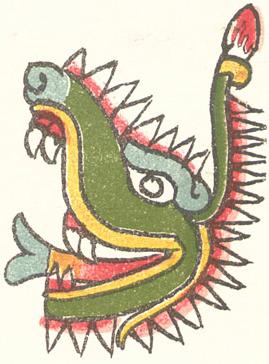|
Pānquetzaliztli
Panquetzaliztli is the name of the fifteenth month of the Aztec calendar. It is also a festival in the Aztec religion The Aztec religion is a polytheistic and monistic pantheism in which the Nahua concept of '' teotl'' was construed as the supreme god Ometeotl, as well as a diverse pantheon of lesser gods and manifestations of nature. The popular religion te ... dedicated to Huitzilopochtli. The correlation of Rafael Tena calculates the twenty-day month as lasting from November 30th to December 9th.El Calendario Mexica y la Cronografía. INAH-CONACULTA Rafael Tena p 104-109 References Aztec calendars Aztec mythology and religion {{time-stub ... [...More Info...] [...Related Items...] OR: [Wikipedia] [Google] [Baidu] |
Aztec Calendar
The Aztec or Mexica calendar is the calendar, calendrical system used by the Aztecs as well as other Pre-Columbian era, Pre-Columbian indigenous peoples of Mexico, peoples of central Mexico. It is one of the Mesoamerican calendars, sharing the basic structure of calendars from throughout the region. The Aztec sun stone, often erroneously called the calendar stone, is on display at the National Museum of Anthropology (Mexico), National Museum of Anthropology in Mexico City. The actual Aztec calendar consists of a 365-day calendar cycle called (year count), and a 260-day ritual cycle called (day count). These two cycles together form a 52-year "century", sometimes called the "Calendar Round, calendar round". The is considered to be the agricultural calendar, since it is based on the sun, and the is considered to be the sacred calendar. Tōnalpōhualli The ("day count") consists of a cycle of 260 days, each day signified by a combination of a number from 1 to 13, and one of th ... [...More Info...] [...Related Items...] OR: [Wikipedia] [Google] [Baidu] |
Aztec Religion
The Aztec religion is a polytheistic and monistic pantheism in which the Nahua concept of '' teotl'' was construed as the supreme god Ometeotl, as well as a diverse pantheon of lesser gods and manifestations of nature. The popular religion tended to embrace the mythological and polytheistic aspects, and the Aztec Empire's state religion sponsored both the monism of the upper classes and the popular heterodoxies. The most important deities were worshiped by priests in Tenochtitlan, particularly Tlaloc and the god of the Mexica, Huitzilopochtli, whose shrines were located on Templo Mayor. Their priests would receive special dispensation from the empire. When other states were conquered the empire would often incorporate practices from its new territories into the mainstream religion. In common with many other indigenous Mesoamerican civilizations, the Aztecs put great ritual emphasis on calendrics, and scheduled festivals, government ceremonies, and even war around key tran ... [...More Info...] [...Related Items...] OR: [Wikipedia] [Google] [Baidu] |
Aztec Calendars
The Aztec or Mexica calendar is the calendar, calendrical system used by the Aztecs as well as other Pre-Columbian era, Pre-Columbian indigenous peoples of Mexico, peoples of central Mexico. It is one of the Mesoamerican calendars, sharing the basic structure of calendars from throughout the region. The Aztec sun stone, often erroneously called the calendar stone, is on display at the National Museum of Anthropology (Mexico), National Museum of Anthropology in Mexico City. The actual Aztec calendar consists of a 365-day calendar cycle called (year count), and a 260-day ritual cycle called (day count). These two cycles together form a 52-year "century", sometimes called the "Calendar Round, calendar round". The is considered to be the agricultural calendar, since it is based on the sun, and the is considered to be the sacred calendar. Tōnalpōhualli The ("day count") consists of a cycle of 260 days, each day signified by a combination of a number from 1 to 13, and one of th ... [...More Info...] [...Related Items...] OR: [Wikipedia] [Google] [Baidu] |


